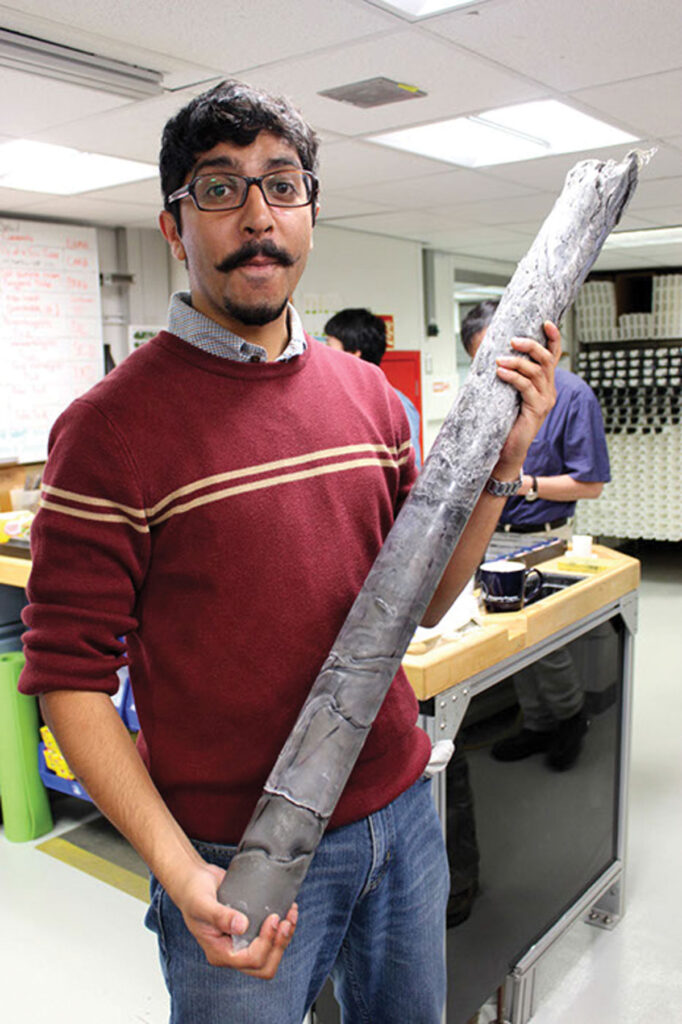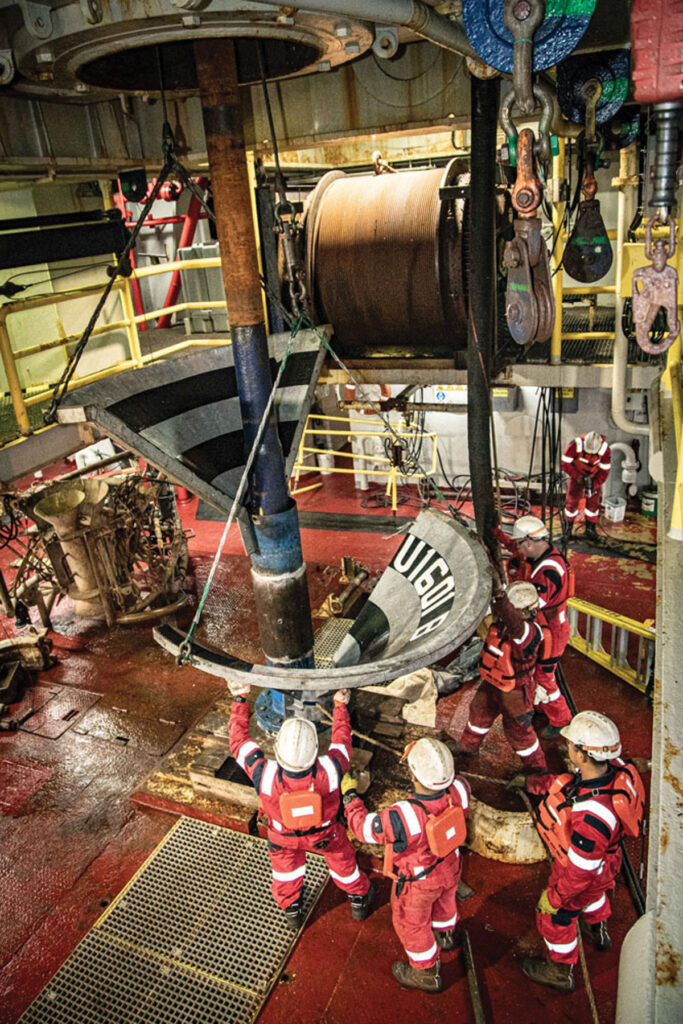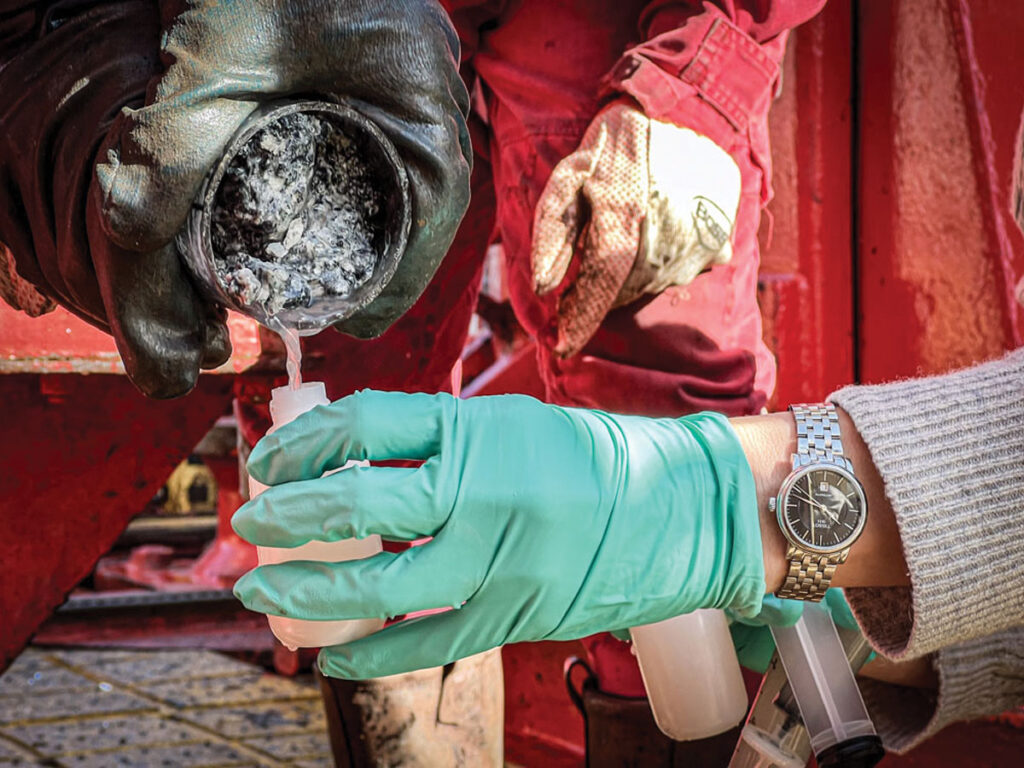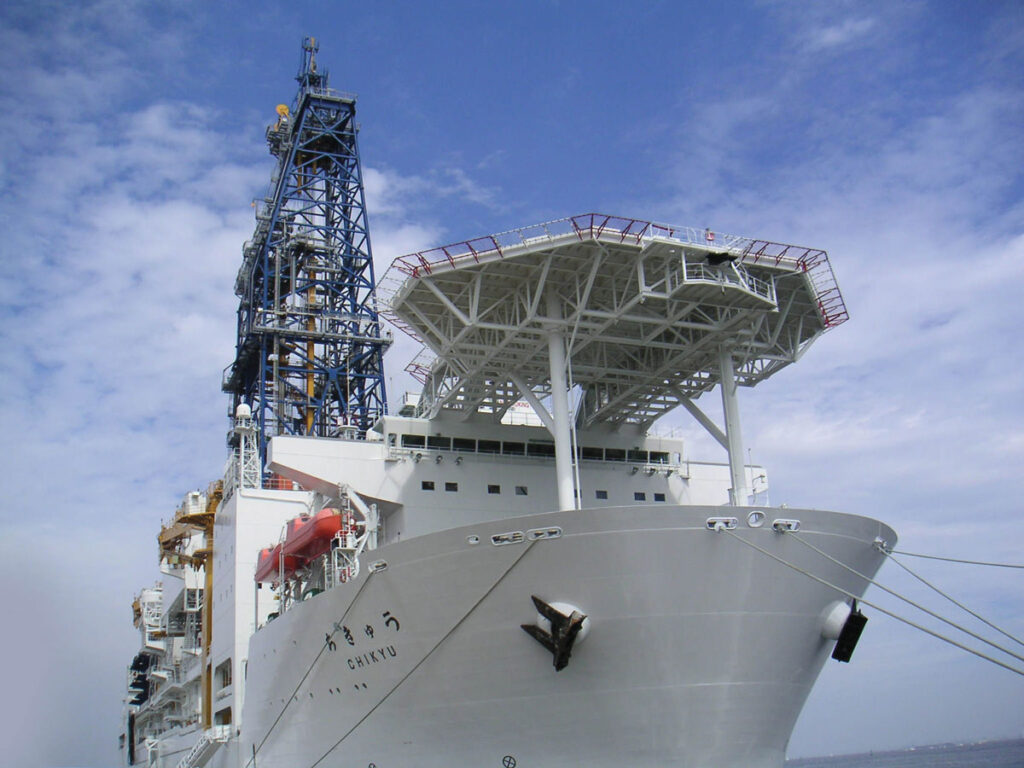For Kaustubh Thirumalai, a 2-month cruise aboard the research vessel JOIDES Resolution was “an experience that changed my life.” Now an assistant professor of geosciences at the University of Arizona, Thirumalai was one of 30 scientists aboard the ship on a 2014 expedition that was drilling into sediments at the bottom of the Bay of Bengal to learn about the history of the South Asian summer monsoon.
Thirumalai worked 12-hour shifts 7 days per week as a sedimentologist on Expedition 353, nicknamed the “iMonsoon.” He examined the core segments that plopped on deck every 45 or so minutes—”the best job on the cruise,” he said.

The people he worked with “became like a family,” celebrating the holidays with Christmas carols and a New Year’s dance party and marking Thirumalai’s birthday by wearing false mustaches to match his impressive ‘stache. “The whole thing was like science camp, and that was awesome,” he said.
The awesome experiences are about to come to an end. The National Science Foundation (NSF), which funds scientific ocean drilling, announced in March 2023 that JOIDES ( Joint Oceanographic Institutions for Deep Earth Sampling) Resolution (JR) will retire in September 2024. The agency said a budget crunch, the end of an international agreement, and the pending expiration of the ship’s current environmental impact statement left NSF with little choice.
“It’s clear to us that the current model of U.S. scientific ocean drilling lacks international support, so we need a new model,” said James McManus, director of NSF’s Division of Ocean Sciences, during a 6 July 2023 virtual town hall meeting. “It’s imperative that we start planning for the next phase of scientific ocean drilling now, because any plans will take time to fully realize.”
Some scientists, however, have complained that NSF hasn’t prepared for any real transition. It has no plans to build or acquire a replacement ship, and although the agency said it supports the idea of paying to lease drilling platforms for specific projects, it hasn’t produced any specifics on how much it can spend on those efforts or when they might begin. In the town hall, McManus said that it’s up to the scientists to tell the agency what they want and need.
“Pulling the plug without a plan for the future cuts us off at the knees,” said Beth Christensen, who chairs the Department of Environmental Science at Rowan University in Glassboro, N.J. “To quote an old saying, it’s penny-wise and pound-foolish. It’s not a tremendous amount of money, and the return on investment in the science is huge.”
A Geology Department at Sea
JOIDES (pronounced JOY-deez) Resolution, which is a modified commercial oil exploration platform, made its first scientific expedition for NSF in January 1985. In the 4 decades since, the 143-meter ship has conducted research in every ocean, from the Arctic to the Antarctic. It can operate in waters up to almost 6 kilometers deep and drill cores up to 2 kilometers long, which can record hundreds of millions of years of Earth’s history.
“Ocean sediments are relatively undisturbed,” said Thirumalai. “They’re sheltered from rain, wind, rivers, and other processes, so we tend to get pristine records that we’re just not able to get on land. We’re looking into Earth’s history book, and we have a much more complete book in the oceans.”

“The JOIDES has honed and fine-tuned the ability to recover pristine core material in immensely complex environments, such as deep-sea locations, or to efficiently handle high core recovery,” said Anna Joy Drury, a research fellow at University College London, who is studying the history of Earth’s oceans and climate during the Mesozoic and Cenozoic periods.
Drury sailed on Expedition 363, in 2016, to the Western Pacific Warm Pool in the Indian and Pacific oceans. “I was part of the night shift, or sunrise shift, and my favorite time of day was to have my lunch on deck watching the Sun come up, before the majority of the ship woke up and swung into action,” she said.
JR is equipped with labs that allow mission scientists to examine and process the cores, take thin slices for microscopic analysis, and conduct other experiments.
“It’s possible to do a lot of analyses at sea,” said Susan Q. Lang, an associate scientist at Woods Hole Oceanographic Institution who earlier this year was co–science leader of Expedition 399, “Building Blocks of Life.” The ship journeyed to the Atlantis Massif, a region that’s home to a large hydrothermal vent field at the Mid-Atlantic Ridge. The mission extended an existing borehole to a depth of about 2,000 meters and drilled a shallower one at a second location to provide insights into the chemistry that could have given rise to microbial life in the region.
“You can walk off the ship with a lot of data. With 800 meters of core, everyone finds something they like.”
Although most of the analysis begins months after the expedition, when core samples are parceled out to team members, “you can walk off the ship with a lot of data,” Lang said. “With 800 meters of core, everyone finds something they like.”
Although it was Lang’s first trip on the JR, it was a melancholy experience, she said, because it was the first cruise after the retirement announcement. “Even boarding the ship, someone said, ‘Oh, my goodness, this is the last time I’ll be able to walk up the JR gangplank.’”
“It’s like being in a geology department at sea,” said Kenneth Miller, distinguished professor of Earth and planetary sciences at Rutgers University and a member of NSF’s JOIDES Resolution Facility Board. “Everybody’s working very hard, 24/7, in 12-hour shifts. After 30 or 40 days you’re a little shell-shocked, but everybody’s still working together very well.”
Upending Conventional Wisdom
Ocean drilling has allowed scientists to probe many topics, from climate change to the evolution of life on Earth.
“A lot of what we know about Earth really comes from ocean drilling,” said Christensen, who has sailed on three JR expeditions. “Plate tectonics, rapid climate change, evidence for fast glacial advance and retreat, changes in ocean circulation, the pace of sea level rise and fall—I’ve wanted to sit down with a college textbook and a highlighter and highlight how much of environmental science or oceanography or geology is driven by ocean drilling. It’s almost incredible how much we’ve delivered to the citizens of Earth in terms of the understanding of our planet.”

“The whole realm of paleoceanography and paleoclimatology would not exist as it does now without ocean drilling,” said Lawrence Krissek, an emeritus professor of Earth sciences at The Ohio State University and chair of the JR Facility Board. “If you want a record of more than a million years ago, and a continuous record through time, that comes from the ocean floor.”
Contributions have included a better understanding of high–carbon dioxide periods driven by natural climate variations, Krissek said, along with a better understanding of the processes that drive earthquakes, the causes of changes in global sea level, and the subseafloor biosphere. “Twenty-five years ago, the conventional wisdom said there were no microbes below a few tens of meters. That’s not true. Almost everywhere we’ve drilled, as deeply as we’ve drilled, there’s life. Who knows what these bugs will tell us about the origin of life?”
Krissek sailed on eight JR expeditions, including its fourth, after traveling on the ship’s predecessor, Glomar Challenger. “I’m a frequent floater,” he quipped. “I’m sure it demonstrates some deep personality flaw, but I love to do cores. When we get to the end of a shift, if I can say, ‘We described 150 meters of core today,’ I get a certain satisfaction from that. That’s what took me to sea repeatedly.”
Krissek said he’s seen a lot of changes since his first trips aboard JR. “One big improvement is the ability to contact home,” he said, with a progression from ham radio to limited email to satellite telephone calls at $10 per minute (“you didn’t talk very often”) to today’s almost constant contact.
Not every day at sea was a good one, though. In 1995, during Expedition 163, which studied the process of ocean formation off the coast of Greenland, the ship was caught in a severe storm. “We had 60-foot-plus waves and 100-mile-per-hour-plus winds,” Krissek said. “One of the waves broke out a window on the bridge, so a whole bunch of water flooded in. If not for some quick action by the crew and some of the technicians, we could have been in big trouble.” The expedition was abandoned as JR returned to port for repairs.
Losing Expertise
Today the big trouble for JOIDES Resolution is money. In the 6 July town hall, McManus reported that expenses have ballooned over the past decade, with costs for the most recent fiscal year totaling $72 million. NSF receives a line-item appropriation of $48 million per year to fund JR, which is operated by Texas A&M University. Some of the costs are borne by Europe and Japan, partners in the International Ocean Discovery Program (IODP). Partner contributions, however, have dropped from $16.5 million in 2015 to $12.5 million in 2023, with even smaller payments expected in the future.

“NSF is in an extremely tight spot,” said Keir Becker, an emeritus professor of marine geosciences at the University of Miami. “The decadal survey in 2015 said that ocean drilling and the JR were very important, but it flagged the fact that the cost per berth was much higher for U.S. researchers than for the international partners. But they have their own fiscal constraints, so they couldn’t increase their contributions.”
Becker has logged 22 ocean drilling cruises, including 17 on JR, and about 40 additional research cruises. “I’ve spent almost 7 years of my life at sea,” he said.
Becker’s work has included installing instrument packages in boreholes drilled by JR and other ships. They record temperature, pressure, and other environmental factors, and some packages in subduction zones include seismometers. Some are tied in to undersea cable observatories, allowing them to transmit their observations in near-real time. The rest must be retrieved from the ocean floor. Becker has been on many of those recovery missions aboard submersibles.
In addition to the limited partner contributions, the IODP agreement is scheduled to expire in 2024. And even with additional funding, it probably would be too expensive to renew JR’s environmental impact statement when it expires in 2028, the NSF has said, requiring a new ship or other arrangements.
“The biggest challenge will be the loss of expertise. We’ve built up a lot of institutional knowledge over the past 50 years. A lot of small decisions go into how to approach ocean drilling. We’re losing the group that has made these decisions day in, day out.”
The combination of limited funding and expiring agreements left the agency with few options, according to McManus—extend JR operations until 2028 (contingent on finding more money) or demobilize the ship at the end of September 2024, the end of the fiscal year. It chose the shutdown, which will take a few years to implement, as scientific gear will be stripped from the ship in preparation for return to its owner, Overseas Drilling Ltd, and cores will be archived for later analysis.
Some scientists have said the loss of the ship is secondary to the loss of the team that operates the ocean drilling program—roughly 130 employees at Texas A&M who plan the missions, maintain the JR and its instruments, travel with the ship, process and distribute cores, and handle many other tasks.
“The biggest challenge will be the loss of expertise,” said Lang. “We’ve built up a lot of institutional knowledge over the past 50 years. A lot of small decisions go into how to approach ocean drilling, and it’s a lot more complex than I could ever get up to. We’re losing the group that has made these decisions day in, day out.”
“We have this incredible cohort of lab technicians, program managers, drilling engineers, some of whom have been working on the ship since we started,” said Krissek. “I do not know of any way we will be able to keep most of those people.”
Looking for a Plan

Scientists and NSF are trying to determine the path of U.S. scientific ocean drilling after JR completes its final mission, currently scheduled for June–August 2024. A plan may depend in part on the recommendations of the next decadal survey from the National Academies; its interim report is due in late 2023 or early 2024. The previous ocean sciences decadal survey, along with a 2017 survey of ocean drilling scientists, found that JR was a valuable (though increasingly expensive) asset, and many current researchers expect the new report to reach the same conclusion. Without a ship, they say, the field will languish.
“I’m concerned about the U.S. essentially ceding the leadership role in this field that we’ve had for 50-plus years. The U.S.-supplied vessel has been the workhorse in this field. Losing that capability has a large impact both on the U.S. research community and on global drilling efforts.”
“I’m concerned about the U.S. essentially ceding the leadership role in this field that we’ve had for 50-plus years,” Krissek said. “The U.S.-supplied vessel has been the workhorse in this field. Losing that capability has a large impact both on the U.S. research community and on global drilling efforts.”
Current international partners offer some oceangoing capabilities that with NSF funding, American researchers might be able to use.
The Japan Agency for Marine-Earth Science and Technology operates a large drilling ship, the Chikyu, which, using a different technique, can drill deeper than JR. That technique is more expensive, however, and the ship is limited to only one or two cruises per year. The European Consortium for Ocean Research Drilling hires commercial platforms for specific missions, but finding an available ship can be tricky. In addition, there’s no agreement to extend the current alliance beyond 2024.
NSF has proposed “legacy research” involving existing cores. At the end of each mission, each core is split in two. Half is passed along to researchers, and half is archived for future use, when new equipment and techniques will allow scientists to address new questions. The current collection includes about 475 kilometers of cores, split among three major repositories in Texas, Germany, and Japan. Many scientists already poke through these archives to address their own research topics.
“The concept of a legacy expedition has been percolating a while,” said Drury. Such expeditions could allow teams to address big-picture issues that are beyond the scope of a single research cruise, she said, while providing greater access for more researchers.
They also could ensure that “critical knowledge transfer and talent pipeline within the marine geoscience community is not lost, by facilitating the training of future researchers,” Drury said.
Others, however, wondered whether graduate students and early-career researchers will stick with the field if there are no chances to collect new samples.
“I’m especially concerned for the younger generation,” said Becker. “I made my first cruise as a graduate student in the 1970s. That made my career. And I made a lot of contacts. Spending 2 months at sea with esteemed scientists from around the world, you keep those contacts your entire professional life.”
“The cruises are a very good launchpad for early-career folks,” said Lang. “But people go where the opportunities are [and] I think there will be a bit of a missed opportunity” for ocean drilling.
Thirumalai, still an early-career researcher himself, is a little more optimistic. “It’s not a fatal blow,” he said. “It’s a big blow because ocean drilling is such an amazing thing. We’ve lost access to past Earths as a laboratory until we have another ship.… But I don’t necessarily think this is a death note for scientific ocean drilling. I think the community recognizes how valuable it is. If the U.S. doesn’t pick it up, someone else will.”
—Damond Benningfield, Science Writer


